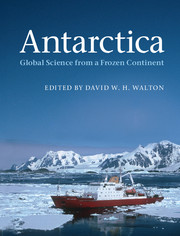Book contents
- Frontmatter
- Contents
- List of contributors
- Introduction
- 1 Discovering the unknown continent
- 2 A keystone in a changing world
- 3 Ice with everything
- 4 Climate of extremes
- 5 Stormy and icy seas
- 6 Life in a cold environment
- 7 Space science research from Antarctica
- 8 Living and working in the cold
- 9 Scientists together in the cold
- 10 Managing the frozen commons
- 11 Antarctica: a global change perspective
- Appendix A Visiting Antarctica
- Appendix B Further reading
- Acknowledgements
- Index
10 - Managing the frozen commons
Published online by Cambridge University Press: 05 March 2013
- Frontmatter
- Contents
- List of contributors
- Introduction
- 1 Discovering the unknown continent
- 2 A keystone in a changing world
- 3 Ice with everything
- 4 Climate of extremes
- 5 Stormy and icy seas
- 6 Life in a cold environment
- 7 Space science research from Antarctica
- 8 Living and working in the cold
- 9 Scientists together in the cold
- 10 Managing the frozen commons
- 11 Antarctica: a global change perspective
- Appendix A Visiting Antarctica
- Appendix B Further reading
- Acknowledgements
- Index
Summary
The Antarctic Treaty is indispensable to the world of science which knows no national or other political boundaries, but it is much more than that. . . it is a document unique in history which may take its place alongside the Magna Carta and other great symbols of man's quest for enlightenment and order.
Laurence Gould, 1960A lawless century: the early years of sealing and whaling
When James Cook had circumnavigated Antarctica in 1775 he reported an abundance of seals, and this caught the attention of the sealing community in the north. Coming mostly from the United States and from the United Kingdom, they hunted both the fur seals for their fur, and the elephant seals for oil. Sealing continued for over a century, but with varying economic returns. The activities peaked around 1820. It has been estimated that a third of the estimated 5.2 million fur seals killed in the south were killed within the Antarctic region. The sealing period was one of no regulations in the southern ocean, and the sealers did not in general publish their geographic discoveries, as such knowledge was of commercial value.
However, several national expeditions carried out geographic explorations, and their activities are well documented. The expedition led by Fabian Gottlieb von Bellingshausen of the Russian Imperial Navy was probably the first to see Antarctica on 27 January 1820. This was 3 days before Edward Bransfield of the British Royal Navy recorded sighting land. Almost a year later, the American sealer Nathaniel Palmer also reported having seen land, and his countryman, the sealer John Davis, may have made the first landing on mainland Antarctica on 7 February 1821. These expeditions would later be used as building blocks in territorial discussions.
- Type
- Chapter
- Information
- AntarcticaGlobal Science from a Frozen Continent, pp. 273 - 300Publisher: Cambridge University PressPrint publication year: 2013
- 4
- Cited by



